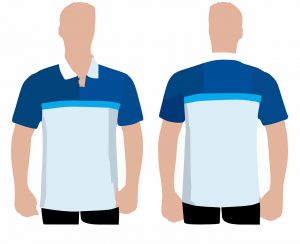Origins of the Polo Shirt
Polos shirts have an interesting history that dates back to the early 1800s. The shirt evolved due to a sporting need for a shirt better suited to the steamy, tropical environment in India.
Today, the iconic polo has become the leisure shirt of choice for most Western males.
Early History
The origins of polo as a sport began in Manipur, India during the early 1800s (for info on the history of Manipur’s polo, check out this site). British soldiers stationed there witnessed the locals playing the sport and began playing it too. The soldiers wore long sleeved cotton shirts—traditional wear at the time. Wearing these shirts proved extremely uncomfortable. To help, they attached collars to protect players from the sun, and buttons, to keep the shirts from moving while riding their horses.
By 1862, the sport made its way to England, and the evolution of the polo shirt continued. John E. Brooks, one of the founders of the well-known American clothing company Brooks Brothers, noticed the ingenuity of the design while on a trip to England. In 1896, Brooks Brothers began producing their version of the button-down collared design.
The shirt continued to gain popularity, and, in 1920, an Argentine-Irish polo player named Lewis Lacey began selling polo shirts with an embroidered image of a polo player on them.
The Tennis-Polo Evolution
By the late 1920s, designers began searching for a better style of men’s sports shirt. René Lacoste, a seven-time Grand Slam tennis champion, found most shirts of the era to be uncomfortable and impractical. Additionally, tennis had become more competitive, and players were looking for ways to better their game. This included what they wore. Lacoste designed a shirt for tennis players with shorter sleeves and fewer buttons down the front. The shirt was also made with pique cotton, a lightweight material that allowed the shirt to breathe and keep the players cool. The collars on these new shirts were unstarched and flat, allowing for a wider range of motion.
After he had debuted the shirt at the 1926 US Open, it became so popular that he established the La Chemise Lacoste Company. By 1933, he was mass-marketing his shirts to the tennis community. Almost twenty years later, in 1951, Lacoste began manufacturing his shirts in a variety of colors other than the traditional white worn by tennis players. He started selling these shirts in high-end department stores, and they became a status symbol for any who could afford them. Soon, the short sleeved, soft-collared shirts produced for tennis and polo became known as the “polo shirt.”
The shirt continued to evolve in the 1950s. Peter Hill began to produce shirts of an even lighter weight, open knit fabric that kept the body’s temperature cool or warm depending on the climate. By the 1960s, polo shirts were being worn off the courts and fields as well by fashion-conscious youth looking for something stylish that did not require a tie. Prominent figures like U.S. Presidents John F. Kennedy and Dwight Eisenhower helped fuel the popularity of the shirts by wearing them in public settings.
The Ralph Lauren Polo
In 1972, Ralph Lauren picked up the polo shirt for his own line, establishing his casual wear company that would from then on be known as “Polo,” an ode to the sport of the wealthy and thus a symbol of prominence. He kept the polo player logo as a symbol of his brand. Once Lauren started making them, the shirt made its way into more and more men’s wardrobes. Wearing the shirt became a status symbol.
Over time, polo shirt usage spread from polo to tennis and, later, golf. Each sport adopted the shirt as standard wear for the participants. While the material may differ, the design and functionality of the polo shirt remained the same.
Polo Shirts Today
From the 1990s until today, the polo shirt became standard attire as “business casual” workwear. Many schools have adopted it as part of their school uniform. Companies manufacture polos in various colors and designs. The iconic polo image is still used though other companies often substitute their own brand’s logo.
Made from a variety of fabrics, polos are worn in casual settings and at professional events. While these articles of clothing stemmed from a desire for comfort and functionality while playing sports, they have become a staple of a man’s casual wear wardrobe. These fashionable and comfortable shirts vary in price, depending on the design and brand. For an excellent selection at reasonable prices, try our online store.



